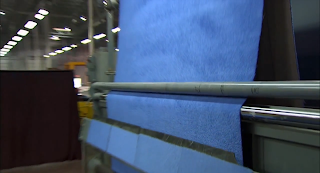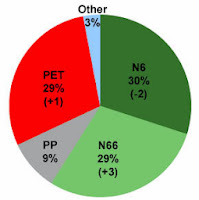In 2009, 84.9% of nearly 300 million used tires were diverted from landfills nationwide. In 1990, that number was approximately 15%. What factors helped make the tire recycling industry so successful?
Akin to carpet, used tires are bulky and do not degrade in landfills. Tires also have a huge amount of embedded energy: a single tire requires 5 gallons of oil for raw materials and another 2 gallons of oil to supply the energy for manufacturing (five pounds of oil go into a single pound of nylon). Unlike carpet, whole tires consist of 70% empty space and can fill up with methane when landfilled, causing them to become buoyant, float to the top, and damage the landfill’s liner.
Minnesota was the first state to ban whole tires from landfills in 1985 and since then haveve been banned from an additional
38 states. While tire stockpiles existed prior to the landfill bans, they began to grow quickly after the bans were enacted. Improperly stored tires can serve as mosquito and rodent breeding grounds. While tires cannot be ignited easily, once lit, they are very difficult to extinguish and release thick, black toxic smoke.
A series of tire fires during the 1980s and 90s put pressure on policy makers for a solution. In 1983, a fire in Winchester, Virginia burned several million tires and was declared a Superfund site. A grass fire ignited an unlicensed tire stockpile in Tracy, California in August 1998 and burned for 26 months before finally being extinguished. During that period, a second tire fire broke out in Wesley, California from a lightning strike.
California lawmakers were galvanized by the fires and authorized CalRecycle to manage the tire waste stream. The fee on tire sales was increased in order to fund an array of grants, loans, and incentives for producers and potential users of tire-derived products. The program provided basic support and technical advice for launching products and navigating the approval process for public works projects. Since nobody wants to be the first to use a new product, case studies were commissioned to demonstrate the benefits of the new products. California, other states, and the federal governments used procurement policies to drive the market for tire-derived products.
There are now numerous applications for reused or downcycled tires. One-third of all diverted tires are used for rubberized asphalt or ground cover for playgrounds and running tracks. Whole or shredded tires can be reused as barriers around racetracks, bumpers on docks, or
civil engineering projects to form embankments or improve soil drainage. Given the inherent energy in tires, nearly one-half of diverted tires are used for waste-to-energy fuel production.
As you can see, there were many factors that helped make tire recycling successful. Tires were stockpiled long before any regulation because they were recognized as valuable but no viable products could be brought to market. An unfortunate series of disasters led California lawmakers to establish a fund to provide market assistance to companies to bring new products to market. Over time, the market approach has been successful and the industry has matured to include several viable companies. California exceeded a 90% diversion rate for tires for the first time in 2012.
CARE is working closely with the carpet industry, recycling entrepreneurs and local municipalities to tackle the challenges of carpet recycling. Carpet is not a hazardous waste like tires, but it does contain valuable raw materials and energy which can be recovered and recycled. The aspirational goal of CARE is that no carpet goes to landfill in the future. We are looking for great ideas to help accomplish this goal. Contact CARE’s Executive Director, Bob Peoples at
bpeoples@carpetrecovery.org to learn more.















